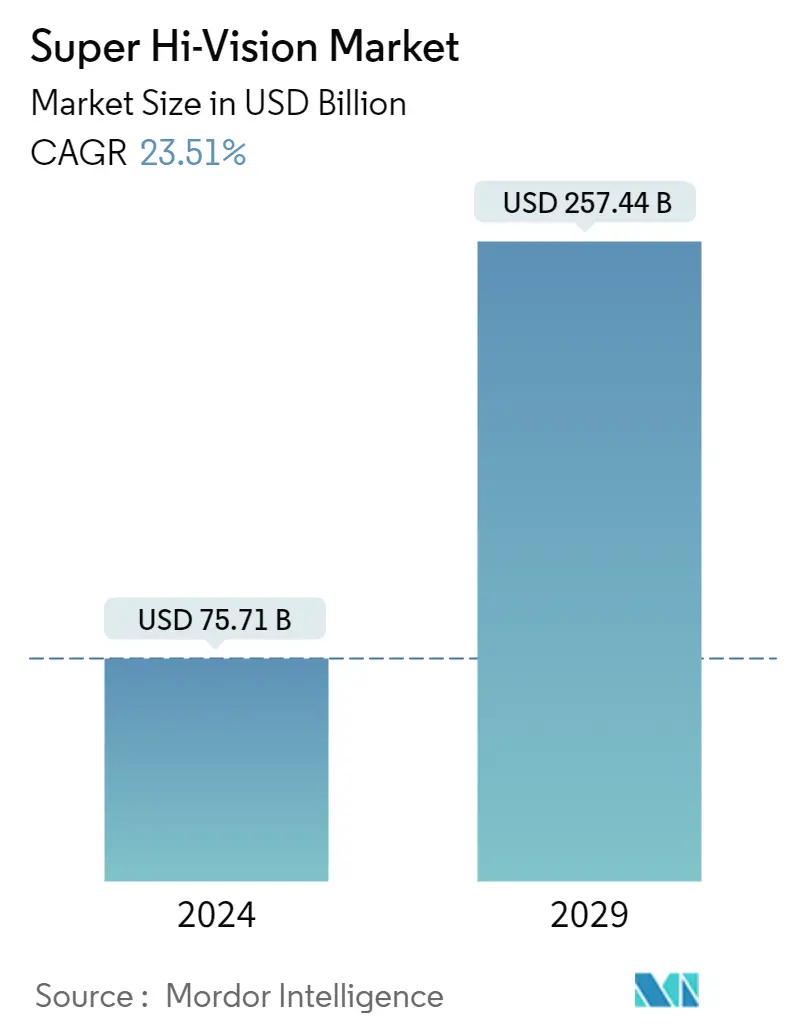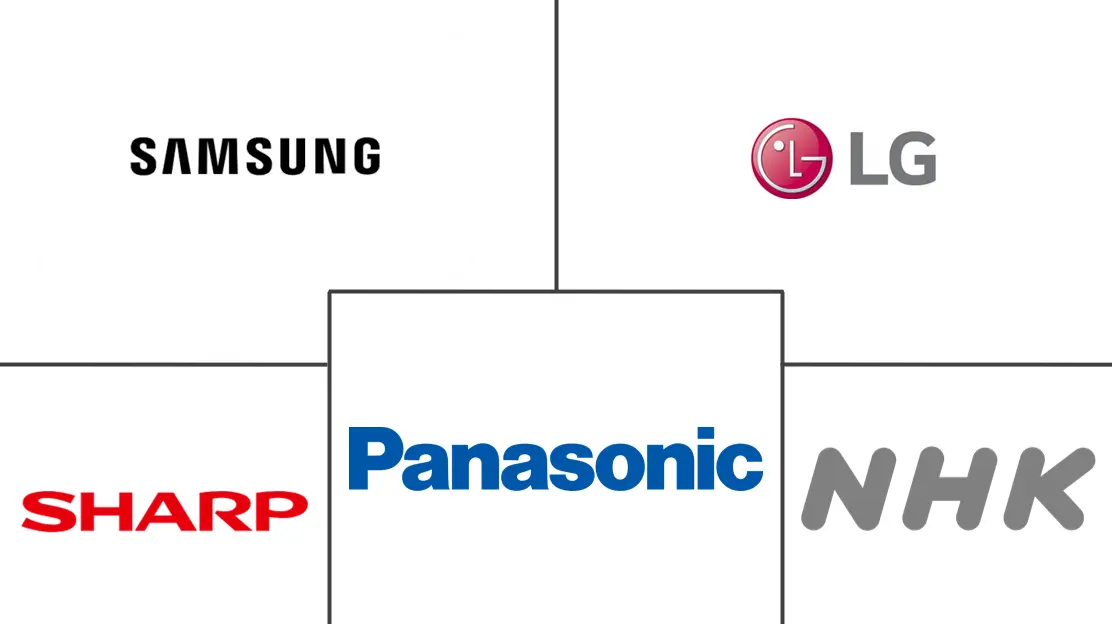Market Size of Super Hi-Vision Industry

| Study Period | 2019 - 2029 |
| Market Size (2024) | USD 75.71 Billion |
| Market Size (2029) | USD 257.44 Billion |
| CAGR (2024 - 2029) | 23.51 % |
| Fastest Growing Market | Asia Pacific |
| Largest Market | North America |
Major Players
*Disclaimer: Major Players sorted in no particular order |
Super Hi-Vision Market Analysis
The Super Hi-Vision Market size is estimated at USD 75.71 billion in 2024, and is expected to reach USD 257.44 billion by 2029, growing at a CAGR of 23.51% during the forecast period (2024-2029).
- Ongoing advancements in display technology, camera technology, and video compression techniques are enabling the creation, distribution, and consumption of Super Hi-Vision content. As technology improves and becomes more accessible, the barriers to entry for producing and displaying Super Hi-Vision content are gradually being lowered, anticipated to drive market growth in the coming years.
- The 8K Super Hi-Vision (8K SHV) camera is gaining significant prominence in the market, which represents 16 times of numbers of pixels than numbers of pixels of Full HD (1920 x 1080 pixels) and 4 times 4K Ultra HD (3840 x 2160 pixels). It means that 8K Ultra HD brings 16 times of image data information, equivalent to 16 times digital zoom, which should be equal to Full HD quality. This latest development is also capable of recording 8K in a camera head that is smaller and lighter.
- Rising demand for better-resolution display screens is driving the market. The 8K technology is implemented in different resolutions. Furthermore, the 8K UHD (7680 × 4320 resolution) is best suited for monitors and televisions. Its high pixel count provides better viewing angles and high-clarity images. This segment is expected to account for a major market share as new technologies witness high demand, especially in the case of consumer goods.
- The continuous evolution of display technology in the consumer electronics industry, coupled with the growing consumer preference for high-resolution televisions, has fostered a highly favorable environment for market expansion. Large-screen and high-resolution TVs, in particular, offer superior image quality, delivering a more immersive and lifelike viewing experience. To illustrate, Sharp stands as a prime example with its creation of an 85-inch LCD boasting an impressive resolution of 7,680 horizontal × 4,320 vertical pixels. This remarkable achievement is attributed to the utilization of Sharp's proprietary UV2A technology, which significantly enhances display quality.
- The market is significantly driven by the rising demand for viewing experiences, especially in the entertainment and gaming sectors, and the increasing content creation capabilities. In addition, growing technological advancements supported by the emergence of compatible products and high-speed internet also play a significant role in driving market growth.
- However, the high price and prime cost of 8K products could be a potential factor responsible for restraining the market growth. In addition, super Hi-Vision content and devices might not be completely compatible with existing infrastructure and devices, such as older HDMI standards or streaming platforms. This might decline customer interest in adopting the technology, thereby restraining the market growth.
Super Hi-Vision Industry Segmentation
The super hi-vision is a digital video format referred to as ultra-high definition (UHD) picture quality with impressive 3D sound. Super Hi-Vision market can provide new dimensions to television broadcasting and commercial electronics, camera lenses, medical science, space science, and defense sectors through high-resolution display technology.
The super hi-vision market is segmented by application (healthcare and medical, consumer electronics, commercial, and other applications) and geography and Geography (North America, Europe, Asia-Pacific, Latin America, and Middle East & Africa).
The market sizes and forecasts are provided in terms of value in USD for all the above segments.
| By Application | |
| Healthcare and Medical | |
| Consumer Electronics | |
| Commercial | |
| Other Applications |
| Geography*** | |
| North America | |
| Europe | |
| Asia | |
| Australia and New Zealand | |
| Latin America | |
| Middle East and Africa |
Super Hi-Vision Market Size Summary
The Super Hi-Vision market is poised for significant growth, driven by advancements in display, camera, and video compression technologies. These innovations are making the creation and consumption of Super Hi-Vision content more accessible, thereby reducing entry barriers and fostering market expansion. The demand for high-resolution display screens, particularly 8K technology, is a key factor propelling the market. This technology, offering superior image quality and clarity, is increasingly being adopted in consumer electronics, such as televisions and monitors, to meet the growing consumer preference for immersive viewing experiences. The integration of Super Hi-Vision with emerging technologies like AR and VR further enhances its appeal, creating new market opportunities.
The Asia-Pacific region, with its large consumer base and technological advancements, is a significant contributor to the Super Hi-Vision market. Countries like Japan and China are at the forefront, with Japan investing in 8K content development and China poised to become a major market player due to its infrastructure and manufacturing capabilities. The market is characterized by moderate consolidation, with leading companies like Samsung, LG, and Panasonic focusing on innovation and strategic partnerships to capture market share. Despite the high cost of 8K products and compatibility issues with existing infrastructure, the market is expected to grow, driven by the increasing demand for enhanced visual experiences in entertainment, gaming, and professional applications.
Super Hi-Vision Market Size - Table of Contents
-
1. MARKET INSIGHTS
-
1.1 Market Overview
-
1.2 Industry Value Chain Analysis
-
1.3 Industry Attractiveness - Porter's Five Forces Analysis
-
1.3.1 Bargaining Power of Suppliers
-
1.3.2 Bargaining Power of Buyers/Consumers
-
1.3.3 Threat of New Entrants
-
1.3.4 Threat of Substitute Products
-
1.3.5 Intensity of Competitive Rivalry
-
-
1.4 Assessment of the Impact of COVID-19 on the Market
-
-
2. MARKET SEGMENTATION
-
2.1 By Application
-
2.1.1 Healthcare and Medical
-
2.1.2 Consumer Electronics
-
2.1.3 Commercial
-
2.1.4 Other Applications
-
-
2.2 Geography***
-
2.2.1 North America
-
2.2.2 Europe
-
2.2.3 Asia
-
2.2.4 Australia and New Zealand
-
2.2.5 Latin America
-
2.2.6 Middle East and Africa
-
-
Super Hi-Vision Market Size FAQs
How big is the Super Hi-Vision Market?
The Super Hi-Vision Market size is expected to reach USD 75.71 billion in 2024 and grow at a CAGR of 23.51% to reach USD 257.44 billion by 2029.
What is the current Super Hi-Vision Market size?
In 2024, the Super Hi-Vision Market size is expected to reach USD 75.71 billion.

